U.S. Department of Transportation
Federal Highway Administration
1200 New Jersey Avenue, SE
Washington, DC 20590
202-366-4000
This chapter features safety improvements used on HRRR that were identified by a survey of State, local, and Tribal agencies. The treatments are separated by section under the following categories. Each category has a color coded tab on the bottom of the page to assist with locating specific sections:
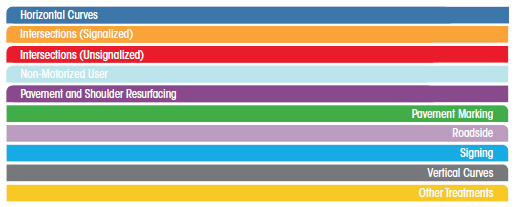
Applicability of "Urban" Treatments to HRRR Several agencies identified treatments used on high risk rural roads even though the treatments are typically viewed as treatments used in urban areas. In these cases, the functional classification of a HRRR did not change when the road passed through a small city or town and was still classified as rural. These treatments include, but are not limited to:
|
Safety improvement treatments on horizontal curves range from low-cost improvements (such as signing) to high-cost improvements (such as modifying road geometry). This section covers safety improvement treatments that can be applied at horizontal curve locations. Some treatments in this section also appear in the sections on intersection improvements, signing, and roadside safety.
| Safety Treatment | For more information, visit page | Cost | Frequency of Maintenance (years) | Safety Benefit | Benefit Cost Ratio19 | |||||
|---|---|---|---|---|---|---|---|---|---|---|
| Initial Implementation | Ongoing Maintenance | NCHRP 500 Performance Rating | Crash Modification Factor (CMF) | Lower Volume*, Optimal Conditions*** | Higher Volume**, Optimal Conditions*** | Lower Volume*, Narrower Conditions**** | Higher Volume**, Narrower Conditions**** | |||
| Install Curve Warning Signs | 11 | $ | $ | 5 | P | 0.7 | 33.8 | 270.1 | 43.5 | 428.4 |
| Install/Update Curve Warning Signs with Fluorescent Yellow Sheeting | 12 | $ | - | 5 | P | 0.66 | 63.1 | 790.4 | 75.1 | 739.9 |
| Double Use of Advanced Warning Signs for Curves or Intersections | 13 | $ | T | |||||||
| Use of Optical Speed Bars | 14 | $ | .075 | |||||||
| Install Chevron Signs | 15 | $$ | $ | 5 | P | 10.6 | 84.7 | 13.0 | 127.7 | |
| Install Arrow Signs at Horizontal Curve Locations | 16 | $$ | - | 10 | P | 27.9 | 222.8 | 37.1 | 336.1 | |
| Install Post-Mounted Delineators at Horizontal Curves | 17 | $$ | - | 10 | P | 0.85 | 5.3 | 42.4 | 6.5 | 63.9 |
| Install Targetted Longitudinal Rumble Strips on the Outside of Horizontal Curves | 18 | $$ | T | 0.82 | ||||||
| Install Icy Curve Warning System | 19 | $$ | E | |||||||
| Improve Superelevation at Horizontal Curve Locations | 20 | $$$$ | P | |||||||
| Remove Compound Horizontal Curves | 21 | $$$$$ | T | |||||||
| Modify Horizontal/Vertical Geometry | 22 | $$$$$ | P | |||||||
Cost: NCHRP 500 Performance rating20 *Lower Volume ≤1000 vpd |
||||||||||
Some of the most serious crashes on rural roads occur at horizontal curves. Horizontal alignment signs, informally called curve warning signs, can improve safety by alerting drivers to changes in roadway geometry that may not be apparent or expected. These signs provide visual information for the driver about the nature of the curve they are approaching, letting them know whether it's a gradual curve, a sharp turn, a hairpin turn, or some combination. Different types of curve warning signs are identified in the MUTCD.
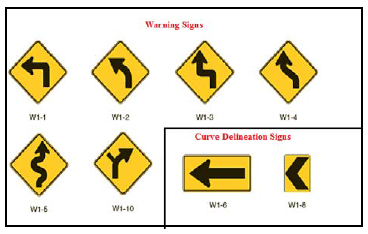
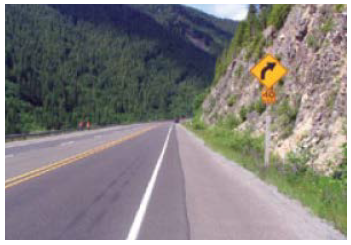
Where to Use: Curve warning signs should be applied to any curve or turn with a history of roadway departure crashes and curves or turns with similar geometry or traffic volumes yet to experience crashes. According to the 2009 MUTCD, warning signs are required on curves or turns where the advisory speed is 10 mph less than the posted speed.
Studies have shown that reductions in crashes due to the installation of curve warning signs are more prominent at locations with higher traffic volumes, sharper curves, or hazardous roadsides.
| Install Curve Warning Signs - Initial Investment: $2,400 - Cost of Maintenance: $1,280 - Frequency of Maintenance: 5 years |
Benefit-Cost Ratio | NCHRP 500 Performance Rating | Crash Modification Factor (CMF) |
|---|---|---|---|
| Lower Volume Optimal Conditions | 33.8 | Proven | 0.70 |
| Higher Volume Optimal Conditions | 207.1 | Proven | 0.70 |
| Lower Volume Narrower Conditions | 43.5 | Proven | 0.70 |
| Higher Volume Narrower Conditions | 428.4 | Proven | 0.70 |
Top Recommended Resources:
1. University of California, Berkley, Institute of Transportation Studies, Technology Transfer Program, Tech Transfer Newsletter, "Signs for Curves and Turns." Available at: http://www.techtransfer.berkeley.edu/newsletter/08-2/signs-for-curves-and-turns.php.
2. FHWA, Roadway Departure Safety: A Manual for Local Rural Road Owners, January 2011. Available at: http://safety.fhwa.dot.gov/local_rural/training/fhwasa1109/fhwasa1109.pdf.
Fluorescent yellow sheeting can improve the effectiveness of curve warning and delineation signs by increasing the conspicuity, or prominent visibility, of the sign, especially during dark conditions.
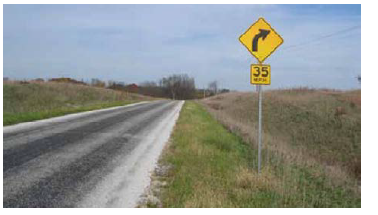
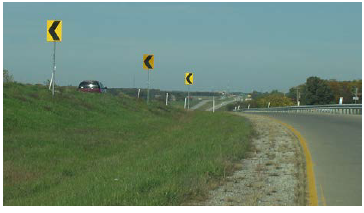
Where to Use: Connecticut DOT used fluorescent yellow sheeting to improve signing at horizontal curves between 2002 and 2006. These curves were selected through a regular program called the Suggested List of Surveillance Study Sites (SLOSSS), which uses crash data, traffic volumes, and roadway characteristics to identify intersections and road segments with higher than expected crash rates.
| Install/Upgrade Curve Warning Signs with Fluorescent Yellow Sheeting - Initial Investment: $1,280 - Cost of Maintenance: n/a - Frequency of Maintenance: 5 years (2 applications) |
Benefit-Cost Ratio | NCHRP 500 Performance Rating | Crash Modification Factor (CMF) |
|---|---|---|---|
| Lower Volume Optimal Conditions | 63.1 | Proven | 0.66 |
| Higher Volume Optimal Conditions | 490.4 | Proven | 0.66 |
| Lower Volume Narrower Conditions | 75.1 | Proven | 0.66 |
| Higher Volume Narrower Conditions | 739.9 | Proven | 0.66 |
Top Recommended Resource:
1. FHWA, Safety Evaluation of Improved Curve Delineation, September 2009. Available at: https://www.fhwa.dot.gov/publications/research/safety/09045/09045.pdf
Doubling the use of either Intersection Ahead warning signs or Curve Ahead warning signs (i.e., on the left and right) is recommended for locations where the crash rates have not been reduced after installation of a single advanced warning sign.
Where to Use: This treatment may be used at locations where crashes indicate that motorists do not heed existing advanced warning signs and additional conspicuity is needed.
| Safety Treatment | Initial Implementation Cost | NCHRP 500 Performance Rating |
|---|---|---|
| Double Use of Advanced Warning Signs | $0 to $5,000 | Tried |
Top Recommended Resource:
1. FHWA, Low Cost Treatments for Horizontal Curve Safety, December 2006. Available at: http://safety.fhwa.dot.gov/roadway_dept/horicurves/fhwasa07002/.
Optical speed bars are transverse stripes spaced at gradually decreasing distances. The rationale for using them is to increase drivers' perception of speed and cause them to reduce speed, which can be helpful near intersections or horizontal curves. The Optical speed bar name comes from this intended visual effect on drivers' speed as they react to the spacing of the painted lines. These white transverse stripes are 18 inches long and 12 inches wide. The preferred material is thermoplastic because of the exposure to traffic volume over time.
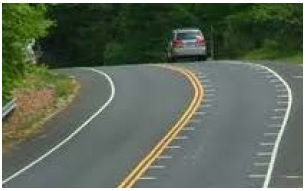
Where to Use: This treatment may be used at locations where speed reductions are needed, such as near intersections and horizontal curves.
| Safety Treatment | Initial Implementation Cost |
|---|---|
| Use of Optical Speed Bars | $0 to $5,000 |
Top Recommended Resource:
1. FHWA, Low Cost Treatments for Horizontal Curve Safety, December 2006. Available at: http://safety.fhwa.dot.gov/roadway_dept/horicurves/fhwasa07002/.
Chevron signs (or curve delineation signs) indicate to drivers the alignment of the roadway when they are within the actual horizontal alignment of a curve. The signs show the shape and degree of curvature, and they guide drivers through the entire curve or turn.
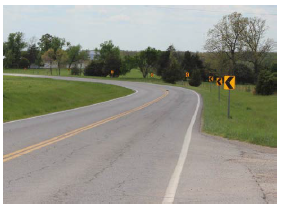
Where to Use: Chevrons should be installed at any curve or turn with a history of roadway departure crashes and at curves or turns with similar geometry or traffic volume yet to experience crashes. According to the 2009 MUTCD, alignment delineation (or a single-directional large arrow) is required on curves or turns where the advisory speed is 15 mph less than the posted speed limit. They can be installed at locations where no chevrons currently exist, or to supplement chevrons that are already in place.
| Install Chevron Signs - Initial Investment: $7,200 - Cost of Maintenance: $3,600 - Frequency of Maintenance: 5 years |
Benefit-Cost Ratio | NCHRP 500 Performance Rating | Crash Modification Factor (CMF) |
|---|---|---|---|
| Lower Volume Optimal Conditions | 10.6 | Proven | 0.75 |
| Higher Volume Optimal Conditions | 84.7 | Proven | 0.75 |
| Lower Volume Narrower Conditions | 13.0 | Proven | 0.75 |
| Higher Volume Narrower Conditions | 127.7 | Proven | 0.75 |
Top Recommended Resource:
1. FHWA, Roadway Departure Safety: A Manual for Local Rural Road Owners, January 2011. Available at: http://safety.fhwa.dot.gov/local_rural/training/fhwasa1109/fhwasa1109.pdf.
Install Arrow Signs at Horizontal Curve Locations The One-Direction Large Arrow sign is used to define a change in horizontal alignment. It can be used alone or to supplement other curve warning signs, such as chevrons.
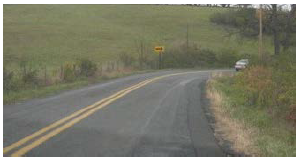
Where to Use: The sign is typically placed on the outside of the curve directly in line with the approaching tangent section. The MUTCD guidance regarding the application of this sign is to install either the One-Direction Large Arrow sign or the Chevron Alignment sign when the Hairpin Curve sign or the Loop sign is installed. Based on standard practice, this sign is limited to sharper curves (turns). It should not be used when there is no advisory speed plaque.
| Install Arrow Signs at Horizontal Curve Locations - Initial Investment: $5,600 - Cost of Maintenance: n/a - Frequency of Maintenance: 10 years |
Benefit-Cost Ratio | NCHRP 500 Performance Rating |
|---|---|---|
| Lower Volume Optimal Conditions | 27.9 | Proven |
| Higher Volume Optimal Conditions | 222.8 | Proven |
| Lower Volume Narrower Conditions | 34.1 | Proven |
| Higher Volume Narrower Conditions | 336.1 | Proven |
Top Recommended Resource:
1. FHWA, Low Cost Treatments for Horizontal Curve Safety, December 2006. Available at: http://safety.fhwa.dot.gov/roadway_dept/horicurves/fhwasa07002/.
When used within horizontal curves, post-mounted delineators with retroreflective sheeting the full length of the post improves driver lane position both at the entry to the curve and at its midpoint.
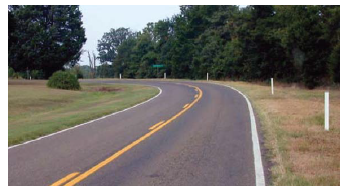
Where to Use: For best results, post-mounted delineators are to be installed on each chevron support post and coupled with edge line and center line pavement markings.
Top Recommended Resource:
1. FHWA, Low Cost Treatments for Horizontal Curve Safety, December 2006. Available at: http://safety.fhwa.dot.gov/roadway_dept/horicurves/fhwasa07002/.
Shoulder or edge line milled rumble strips can be used on roads with a history of roadway departure crashes. While it is recommended that rumble strips be applied systematically along an entire route instead of only at spot locations, where appropriate, they can be used on the outside of horizontal curves and the tangent leading to the curves.
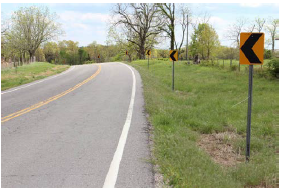
Where to Use: This treatment may be used at horizontal curve locations with a high frequency of roadway departure crashes.
Top Recommended Resource:
1. FHWA, Low Cost Treatments for Horizontal Curve Safety, December 2006. Available at: http://safety.fhwa.dot.gov/roadway_dept/horicurves/fhwasa07002/.
Icy curve warning systems may be installed at problematic areas where ice formation frequently recurs. Using in-pavement weather sensors, icy curve warning signs are activated to alert motorists of upcoming icy conditions.
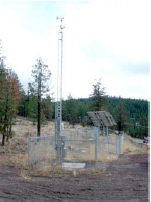
Where to Use: This treatment may be useful in locations that experience recurring icy conditions, such as horizontal curves located in mountain passes.
| Safety Treatment | Initial Implementation Cost | NCHRP 500 Performance Rating | Crash Modification Factor (CMF) |
|---|---|---|---|
| Install Icy Curve Warning System | $5,001 to $20,000 | Experimental | 0.82 |
Top Recommended Resource:
1. Ye, Z., D. Veneziano, and I. Turnbull, Safety Effects of Icy Curve Warning Systems, 2012. Available at: http://www.westernstates.org/projects/coats/Documents/TRB2012/Fredonyer%20ICWS_TRB%20Safety%20Paper_2012-1-23_FINAL.pdf.
Superelevation is the rotation of the pavement on the approach to and through a horizontal curve and is intended to assist the driver in negotiating the curve by counteracting the lateral acceleration produced by tracking. In other words, the road is designed so that the pavement rises as it curves, offsetting the horizontal sideways momentum of the approaching vehicle.
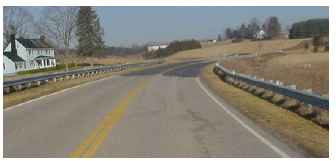
Where to Use: Superelevation is expressed as a decimal representing the ratio of the pavement slope to width, ranging from 0 to 0.12 feet. The adopted criteria allow for the use of maximum superelevation rates from 0.04 to 0.12. Maximum superelevation rates for design are established by policy by each State. Selection of a maximum superelevation rate is based on several variables, such as climate, terrain, highway location (urban vs. rural), and frequency of very slow-moving vehicles. Specific guidance on superelevation rates can be found in A Policy on Geometric Design of Highways and Streets, AASHTO, 2011 and Guidelines for Geometric Design of Very Low-Volume Local Roads (ADT ≤ 400), AASHTO, 2001.
| Safety Treatment | Initial Implementation Cost | NCHRP 500 Performance Rating |
|---|---|---|
| Improve Superelevation at Horizontal Curve Locations | $50,001 to $100,000 | Proven |
Top Recommended Resources:
1. FHWA, Mitigating Strategies for Design Exceptions, July 2007. Available at: http://safety.fhwa.dot.gov/geometric/pubs/mitigationstrategies/.
2. NCHRP Project 17-18(3), Strategy 15.2 A12: Improve or Restore Superelevation (P). Available at: http://safety.transportation.org/htmlguides/horz_crvs/default.htm.
3. AASHTO, Guidelines for Geometric Design of Very Low-volume Local Roads (ADT 400), January 2001.
4. AASHTO, A Policy on Geometric Design of Highways and Streets, November 2011.
Drivers typically expect a single steering setting while negotiating a horizontal curve. Replacing compound curves with a single radius curve better adheres to driver expectations.
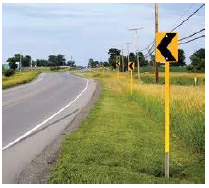
Where to Use: This treatment may be used on HRRR with locations of compound horizontal curves that experience a high frequency of roadway departure crashes. This treatment is especially applicable where other treatments have been applied at the curve location and have not been successful in reducing crashes.
| Safety Treatment | Initial Implementation Cost | NCHRP 500 Performance Rating |
|---|---|---|
| Remove Compound Horizontal Curves | $100,001 and up | Tried |
Top Recommended Resource:
1. NCHRP Project 17-18(3), Strategy 15.2 A13: Modify Horizontal Alignment (P). Available at: http://safety.transportation.org/htmlguides/horz_crvs/default.htm.
Horizontal and vertical geometry may be reconstructed in a variety of ways. For example, horizontal and vertical curves may benefit from increased radii, thereby increasing sight distance. Modifying road geometry may also include eliminating horizontal or vertical curves and providing a more direct alignment.
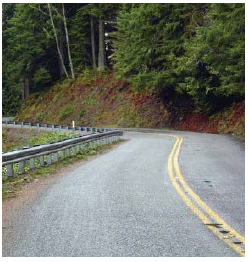
Where to Use: This treatment may be used at locations where improved sight distance is needed and at locations that experience head-on collisions and run-off-road crashes.
| Safety Treatment | Initial Implementation Cost | NCHRP 500 Performance Rating |
|---|---|---|
| Modify Horizontal/Vertical Geometry | $100,001 and up | Proven |
Top Recommended Resource:
1. NCHRP Project 17-18(3), Strategy 15.2 A13: Modify Horizontal Alignment (P). Available at: http://safety.transportation.org/htmlguides/horz_crvs/default.htm.
19 As discussed in Section 1.2, a BCR is only shown where data were available to calculate the ratio. Where data were unavailable, it has been left blank. [ Return to note 19. ]
20 As stated in NCHRP Series 500 Reports (http://safety.transportation.org/guides.aspx). Proven: The safety effect for other similar applications has shown a proven benefit. Tried: The treatment has indications that it can be expected to reduce crashes, but has some conflicting reports as to its associated safety effects or has been deployed and observed to be effective. Experimental: New treatments that still need to be tested and for which the safety effect is unknown. Unknown: Not enough is known about an associated safety performance. [ Return to note 20. ]
